Related Research Articles

Santali, also known as Santal, is the most widely spoken language of the Munda subfamily of the Austroasiatic languages, related to Ho and Mundari, spoken mainly in the Indian states of Assam, Bihar, Jharkhand, Mizoram, Odisha, Tripura and West Bengal. It is a recognised regional language of India per the Eighth Schedule of the Indian Constitution. It is spoken by around 7.6 million people in India, Bangladesh, Bhutan and Nepal, making it the third most-spoken Austroasiatic language after Vietnamese and Khmer.
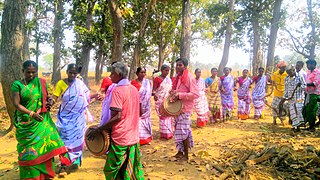
The Santal or Santhal, are a Munda ethnic group in South Asia. Santals are the largest tribe in the Jharkhand and West Bengal state of India in terms of population and are also found in the states of Odisha, Bihar and Assam. They are the largest ethnic minority in northern Bangladesh's Rajshahi Division and Rangpur Division. They have a sizeable population in Nepal and Bhutan. The Santals speak Santali, the most widely spoken of the Munda languages.
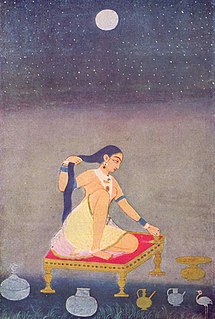
Indian painting has a very long tradition and history in Indian art, though because of the climatic conditions very few early examples survive. The earliest Indian paintings were the rock paintings of prehistoric times, such as the petroglyphs found in places like Bhimbetka rock shelters. Some of the Stone Age rock paintings found among the Bhimbetka rock shelters are approximately 10,000 years old.

Kalighat painting or Kalighat Pat originated in the 19th century in West Bengal, India, in the vicinity of Kalighat Kali Temple, Kalighat, Calcutta, and from being items of souvenir taken by the visitors to the Kali temple, the paintings over a period of time developed as a distinct school of Indian painting. From the depiction of Hindu gods, god, and other mythological characters, the Kalighat paintings developed to reflect a variety of subjects, including many depictions of everyday life.

The Nawab of Bengal was the hereditary ruler of Bengal Subah in Mughal India. In the early 18th-century, the Nawab of Bengal was the de facto independent ruler of the three regions of Bengal, Bihar, and Orissa which constitute the modern-day sovereign country of Bangladesh and the Indian states of West Bengal, Bihar and Orissa. They are often referred to as the Nawab of Bengal, Bihar and Orissa. The Nawabs were based in Murshidabad which was centrally located within Bengal, Bihar, and Odisha. Their chief, a former prime minister, became the first Nawab. The Nawabs continued to issue coins in the name of the Mughal Emperor, but for all practical purposes, the Nawabs governed as independent monarchs. Bengal continued to contribute the largest share of funds to the imperial treasury in Delhi. The Nawabs, backed by bankers such as the Jagat Seth, became the financial backbone of the Mughal court. During the 18th century, the Nawabs of Bengal were among the wealthiest rulers in the world.

East India House was the London headquarters of the East India Company, from which much of British India was governed until the British government took control of the Company's possessions in India in 1858. It was located in Leadenhall Street in the City of London. The first East India House on the site was an Elizabethan mansion, previously known as Craven House, which the Company first occupied in 1648. This was completely rebuilt in 1726–29; and further remodelled and extended in 1796–1800. It was demolished in 1861. The Lloyd's building, headquarters for Lloyd's of London, was built on the site of the former East India House.

Prafulla Chandra Chaki was an Indian revolutionary associated with the Jugantar group of revolutionaries who carried out assassinations against British colonial officials in an attempt to secure Indian independence.

Nandalal Bose was one of the pioneers of modern Indian art and a key figure of Contextual Modernism.
Mildred Archer OBE was an English art historian who specialized in 18th- and 19th-century art in British India. She was curator of Prints and Drawings at the India Office Library and wrote extensively on the collection and studies on them.
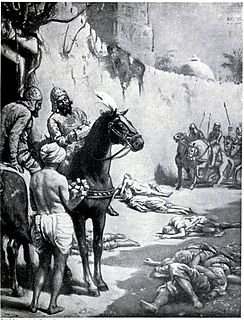
Ikhtiyār al-Dīn Muḥammad Bakhtiyār Khaljī, also known as Bakhtiyar Khalji, was a Turko-Afghan military general of the Ghurid dynasty, who led the Muslim conquests of the eastern Indian regions of Bengal and Bihar and established himself as their ruler. He was the founder of the Khalji dynasty of Bengal, which ruled Bengal for a short period, from 1203 to 1227 CE.
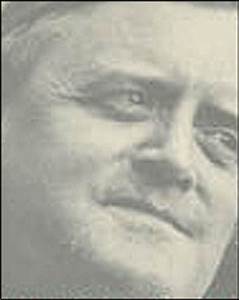
Harry Verrier Holman Elwin was a British-born Indian anthropologist, ethnologist and tribal activist, who began his career in India as a Christian missionary. He first abandoned the clergy, to work with Mahatma Gandhi and the Indian National Congress, then converted to Hinduism in 1935 after staying in a Gandhian ashram, and split with the nationalists over what he felt was an overhasty process of transformation and assimilation for the tribals. Verrier Elwin is best known for his early work with the Baigas and Gonds of Orissa and Madhya Pradesh in central India, and he married a 13 year old member of one of the communities he studied. He later also worked on the tribals of several North East Indian states especially North-East Frontier Agency (NEFA) and settled in Shillong, the hill capital of Meghalaya.
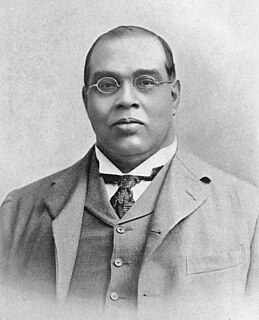
Romesh Chunder Dutt was an Indian civil servant, economic historian, writer and translator of Ramayana and Mahabharata. Dutt is considered a national leader of the pre-Gandhian era, and was a contemporary of Dadabhai Naoroji and Justice Ranade.He was one of the prominent proponent of Indian economic nationalism. He along with Dada bhai and Dinahaw wacha put forward "Drain Theory" to explain British exploitation.

The culture of Bengal defines the cultural heritage of the Bengali people native to eastern regions of the Indian subcontinent, mainly what is today Bangladesh and the Indian states of West Bengal and Tripura, where the Bengali language is the official and primary language. Bengal has a recorded history of 1,400 years. The Bengali people are its dominant ethnolinguistic group. The region has been a historical melting point, blending indigenous traditions with cosmopolitan influences from pan-Indian subcontinental empires. Bengal was considered to be the richest part of Islamic medieval India and during the era of the Bengal Sultanate it was described to be a major trading nation in the world, while during Mughal times, having triggered the proto-industrialization, its economy was worth 12% of global GDP. However, significant socio-economic inequalities existed during this period. As a part of the Bengal Presidency, it also hosted the region's most advanced political and cultural centers during British rule. Historically Feudalism has been widespread in the entire eastern Indian region. The feudal system flourished to a large extent under the British administration, which served as a means to exploit the Indian peasants by the British colonizers. This created a class of rich landlords in Bengal and a large population of poor peasants. It is noteworthy that a major portion of the Bengali intellectual community during the British era emerged from this wealthy class of landlords, as primarily they belonged to well educated families and got the economic opportunities to receive English education, often from abroad. The lower social classes remained in abject poverty and illiteracy. Thus, although the contribution of the Bengali intellectual community has been immense towards literature, science, politics and the Indian freedom movement, but still as it flourished under an exploitative imperial government, it mostly constituted of individuals belonging to the wealthy landlord families.

Company style or Company painting is a term for a hybrid Indo-European style of paintings made in India by Indian artists, many of whom worked for European patrons in the British East India Company or other foreign Companies in the 18th and 19th centuries. The style blended traditional elements from Rajput and Mughal painting with a more Western treatment of perspective, volume and recession. Most paintings were small, reflecting the Indian miniature tradition, but the natural history paintings of plants and birds were usually life size.
Fazl Ali OBE was an Indian judge, the governor of two Indian states, and the head of the States Reorganisation Commission which determined the boundaries of several Indian states in the December 1953.Their commission submitted the report in September 1953 broadly accepting the language as the basis of reorganisation of states.

Sir Charles D'Oyly, 7th Baronet (1781–1845), was a British public official and painter from Dacca. He was a member of the Bengal Civil Service based in Calcutta, Dacca and Patna from 1797 to 1838. Although he held senior positions with the East India Company's civil service, he is best known as an amateur artist who published many books featuring engravings and lithographs featuring Indian subject matter.
The Mal Paharia people are a Dravidian ethnic people of India, mainly living in the states of Jharkhand and West Bengal. They are the original inhabitants of the Rajmahal Hills, known today as the Santal Parganas division of Jharkhand. They are listed as a Scheduled Tribe by the governments of West Bengal, Bihar and Jharkhand. They speak the Malto language, a Dravidian language, as well as a poorly-documented Indo-Aryan Mal Paharia language.

Orissa Province was a province of British India created in April 1936 by the partitioning of the Bihar and Orissa Province. Its territory corresponds with the modern-day State of Odisha.
Avinash Chandra was an Indian painter, who lived and worked in the United Kingdom.
Krishnaut or Krishnaut Ahir or Krishnaut Yaduvanshi is a clan of the Hindu Yadav (Gopa) caste found in Bihar, Jharkhand, and parts of the Indian state of Uttar Pradesh. The term Krishnaut denotes their claimed descent from Lord Krishna.
References
- 1 2 3 4 5 6 "William Archer". Open University . Retrieved 4 August 2018.
- 1 2 3 4 Skelton, Robert (1979). "Obituary: William George Archer". Journal of the Royal Asiatic Society of Great Britain and Ireland. 2: 186–188. doi: 10.1017/S0035869X00135798 .
- 1 2 3 4 "Mildred Archer". The Independent. 9 October 2011. Retrieved 4 August 2018.
- 1 2 3 4 "Diaspora-artists: View details". Diaspora Artists. Retrieved 4 August 2018.
- ↑ "Correspondence about the making of the BBC Monitor film on Avinash Chandra". The National Archives . Retrieved 4 August 2018.
- ↑ "W.G. Archer". BBC Genome . Retrieved 4 August 2018.
- ↑ British Empire: "No. 38161". The London Gazette (Supplement). 30 December 1947. p. 26.
- ↑ "Papers of W G Archer, Indian Civil Service, Bihar 1931-47, and of his wife Mildred Archer, experts on Indian poetry and art". The National Archives . Retrieved 4 August 2018.